PLANTS | ANIMALS | ECOLOGY | FUNGI | GEOLOGY | GARDENING | TOOLS
MEXICAN PLANTS & ANIMALS HOME
Excerpts from Jim Conrad's
Naturalist Newsletter
from the January 11, 2019 Newsletter issued from Rancho Regensis north of Valladolid, Yucatán, MÉXICO;
elevation ~40m (~130 ft), N~20.876°, W~88.170°
LEAF-FLOWER FLOWERING
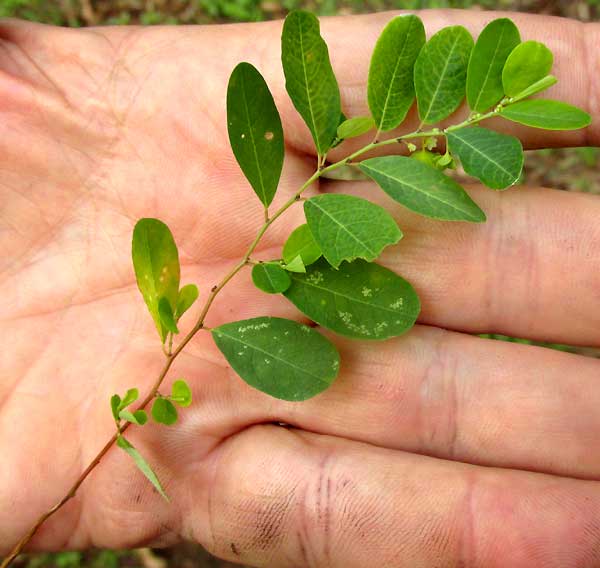
Above you can see an interesting little herb flowering in shaded disturbed areas here at the rancho. One interesting feature is that its slender stems are semi-woody at their bases. Another good field mark is shown below:
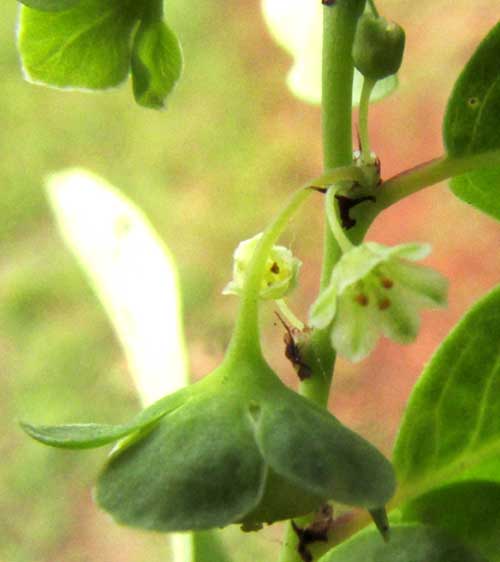
There you see two very different-looking flowers arising from the same leaf axil. The large, green flower dangling toward the picture's base is a unisexual female flower, while the smaller, white flower at right-center is a male flower. A shot of a female flower whose ovary has almost matured into a ripe fruit is shown below:
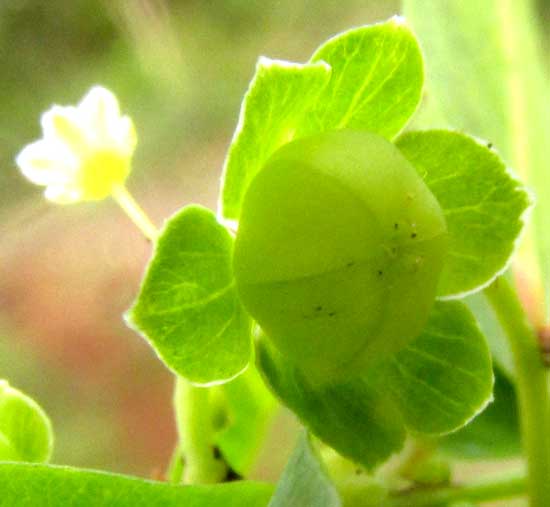
Two tiny male blossoms, each possessing three stamens, appear below:
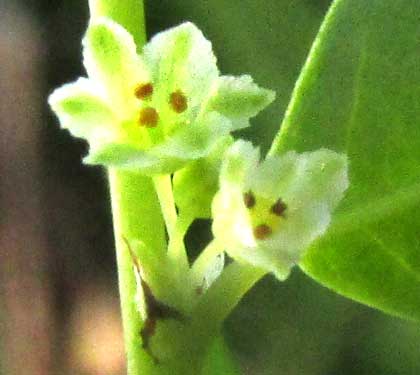
Another interesting feature of the plant is its leaves' venation, which is unusually finely netted, or "reticulate," as shown below:

With the unisexual flowers and the fact that the plant's gross appearance suggests that of a spurge, or euphorbia, of the Spurge/Euphorbia Family, when I started thinking of that family I realized we'd seen similar species before, such as the Smartweed Leaf-flower, Phyllanthus polygonoides, met in 2013 in Texas. You might enjoy comparing our present plant with that one.
So, our rancho plant turned out to be another leaf-flower species, PHYLLANTHUS LIEBMANNIANUS, found from northeastern Mexico south into Belize and Guatemala.
Among the Maya, this plant is considered medicinal, as indicted in the next entry:
from the January 18, 2019 Newsletter issued from Rancho Regensis north of Valladolid, Yucatán, MÉXICO;
elevation ~40m (~130 ft), N~20.876°, W~88.170°
JUAN'S TOOTHACHE, WEEK TWO
Last week I described how our Maya worker Juan came to work with his cheek swollen from a tooth-ache, the cheek plastered with pieces of medicinal herb. He called the commonly occurring herb Hool-k'iim. It was Talinum paniculatum, and its story with pictures appears on our Talinum paniculatum page at ../yucatan/talinum.htm
This week Juan got more serious about treating his pain by concocting a green paste made of three locally common herbs, and he was kind enough to let me document his various doings. His using three herbs instead of one sounds right to me because curanderos, or healers, I've known seldom relied on a single ingredient for their medicines. Their treatments usually consisted of three or more components.
First we went to the same place as before, to pick more Talinum paniculatum leaves. Then we walked just a few feet, to the other side of the shaded compost area, and picked a few leaves of Leaf-flower, Phyllanthus LIEBMANNIANUS, profiled above. Below, you can see Juan collecting his Leaf-flower leaves:
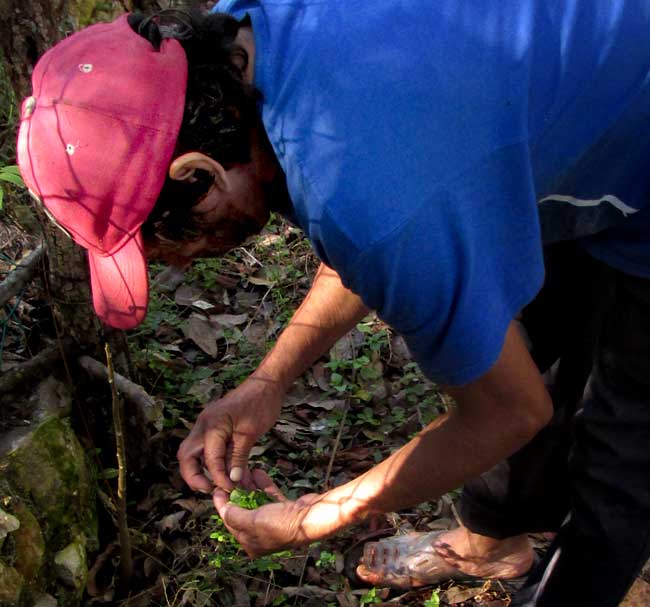
Notice that Juan isn't picking the whole plant, just removing leaves. The slender, wiry stem of Phyllanthus LIEBMANNIANUS is semi-woody, so Juan placed the stem between two fingers and raked upward, the leaves coming off individually. "Now the stem will grow new leaves," he said.
Next we gathered a few leaves of Square-stemmed Misteletoe, Phoradendron quadrangulare, parasitizing a nearby Bay Cedar, Guazuma ulmifolia. Our Square-stemmed Mistletoe page is at ../yucatan/mistlet3.htm
Below, you can see the entire collection of leaves from the three above species:
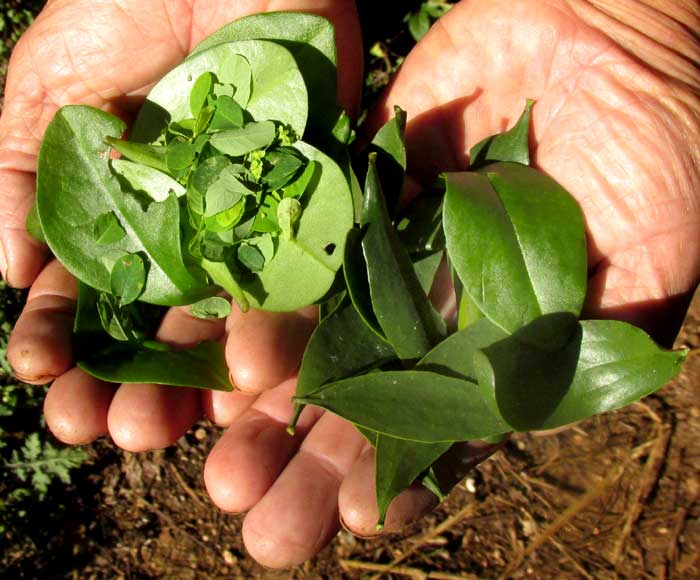
On the picture's left side, the larger leaves at the bottom are from Talinum paniculatum. Atop them lie the Leaf-flower's leaves, and on the right side of the picture you see the mistletoes's blades.
On our pages for the above plants we've already noted that these species are recognized widely as medicinal plants. Studies have shown that, in rats, extracts of roots and leaves of Talinum paniculatum produced "estrogenic activity... which can be helpful in managing reproductive tissues regression during menopause... " Extracts of the Square-stemmed Mistletoe affect "cytotoxicity, apoptosis, tumour inhibition, induction of immune processes and antioxidant activity." Leaf-flower is much used in India's Ayurvedic system of medicine for a long list of problems, including, gonorrhea and other genital afflictions, diarrhea, dysentery, intermittent fevers, ophthalmopathy, scabies, ulcers and general wounds."
Now it was time to mash the leaves into a green paste. Normally Juan uses as a grinding bowl, or morter, half of a gourd-like jícara fruit from what's sometimes called the Calabash Tree (Crescentia cujete. That interesting tree is profiled at ../yucatan/calabash.htm
However, Juan's jícara was filled with something else, so he used the bottom of a liter-size Coca-Cola plastic bottle, as shown below:
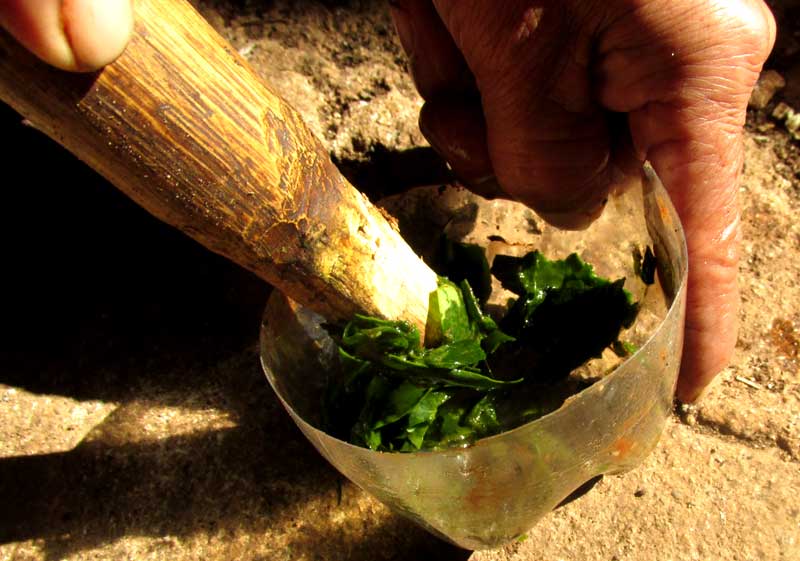
The grinder, or pestle, is just a solid piece of a young tree trunk quickly carved with a machete blade.
from the December 24, 2007 Newsletter issued from Yerba Buena Clinic just outside Pueblo Nuevo Solistahuacan, Chiapas, MÉXICO
about 1740 meters in elevation, ± LAT. 17° 11' 27"N, LONG. -92° 53' 35"W
DON JESÚS'S BLUE CORDUROY BAG
Several local men are employed at Yerba Buena establishing a blackberry plantation. Each afternoon they come to my dwelling, an abandoned ruin of a former duplex, to store their tools overnight. The other day as they were going home I saw that one of them, Don Jesús
(pronounced heh-SOOS) carried a blue corduroy bag absolutely stuffed with plants he'd picked for taking home. Below, you can the Don and his stuffed bag .
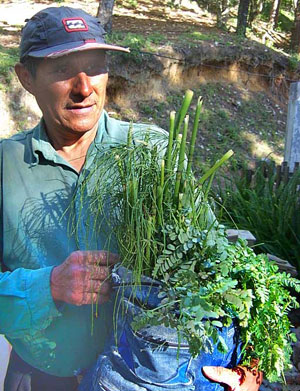
The thick-stemmed plant on the left is one of the horsetails, genus EQUISETUM. Horsetails are spore- producing "fern allies," considered to be very primitive plants. During the Mississippian Period over 300,000,000 years ago horsetails were dominant land plants. Later gymnosperms arose and largely displaced the Earth's forests of giant horsetails.
A close-up of the other plant in the Don's bag is shown below.
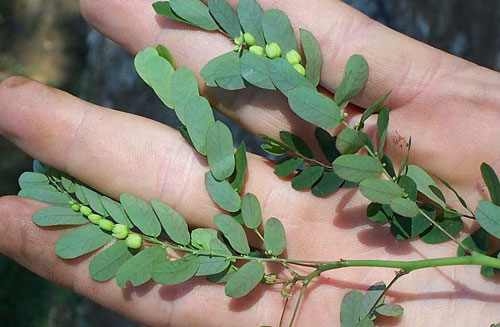
These plants are sometimes called Leaf-flowers. They're in the genus PHYLLANTHUS. In the old days Phyllanthus was placed in the Euphorbia Family but recent genetic studies indicate that it's such an unusual genus that it deserves its own family, the newly constituted Leaf- flower Family, or Phyllanthaceae.
One unusual thing about leaf-flowers is that their leaves line up opposite one another along the stem and in the same plane, causing the leafy stem to look like a Black Locust's pinnately compound leaf. In the picture you can see that the plant's ultimate sections are leafy stems instead of pinnately compound leaves, however, because flowers arise at the base of each leaf. Flowers never occur at the base of compound leaf leaflets. When leaves line up opposite one another in the same plane they're said to be two-ranked, or "distichous." The effect can be pretty, as shown below:

Our leaf-flower species is common on the moist, semi- shaded floors of woods. Twelve Phyllanthus species* are listed for Chiapas, but Phyllanthuses range from being fragile-looking herbs like this one to fair-sized trees. You may recall my telling about the Yucatan's Grosellas, which are small trees producing acidy fruits. That species is often known as Phyllanthus acidus.
Don Jesús called his Phyllanthus "Quiebrapiedra," which means "break-rock." He claims it'll break up kidney stones.
